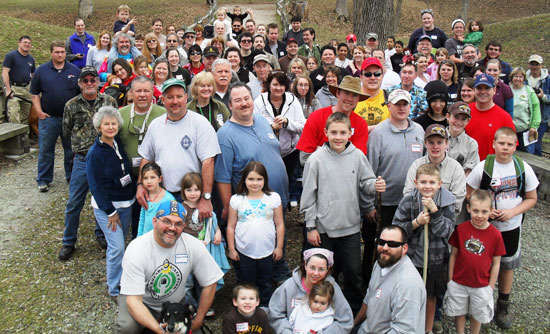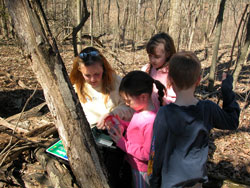
Geocache flash mob at Mounds State Park.
Geocaching at Indiana DNR Properties
What is geocaching?
Geocaching is a sport that is a little like hide-and-seek on a landscape scale for outdoor enthusiasts. Individuals place a "cache," which is generally a small container with a logbook and pencil and maybe a few small trinket items, in a specific location. They note the GPS coordinates, and apply for permission for the cache to be published on the web at http://www.geocaching.com/. If the cache meets the criteria established by Groundspeak, the parent organization of the website, it will be published along with any clues that the person placing the cache has offered. After it is published, individuals may find the clues and coordinates and go look for the cache. They usually write their name or a comment in the logbook and may take a trinket and leave a different trinket they found elsewhere
Some caches do not have containers with logbooks or trinkets - they are just a set of GPS coordinates that lead seekers to a unique place that may have an unusual tree, a great view, or some other significant feature. In Indiana's policy, these are called "containerless caches."
Policy highlights
We support geocaching on Indiana DNR properties and welcome the placement of caches and containerless caches within the framework of our geocaching policy, which is designed to balance outdoor recreation with natural and cultural resource conservation.
The policy for geocaching on Indiana DNR properties was established in 2005. Revisions were made in cooperation with the geocaching community and with Groundspeak's involvement. View the policy.
Some key elements of Indiana DNR’s geocaching policy are listed below. Remember, however, that you are responsible for reading and following the entire policy when you place or seek caches.

Placing caches
- Caches, as defined by Indiana DNR, have containers and logbooks.
- Placement of a cache in an Indiana state park, reservoir, state forest, state fish and wildlife area or off-road riding area requires a license. Access the application online at Official Geocaching Placement Permit (54539). The property manager at each site makes the final determination regarding approval of a license and no cache will be published at geocaching.com without property manager approval.
- The number of caches that may be placed on an Indiana state park, reservoir, state forest, or off-road riding area is determined by acreage. The maximum number of caches for any property 10,000 acres or more is 50.
- Caches may not be placed more than 25 feet from developed roads or trails.
- Caches may not be placed in nature preserves.
- Caches may be placed at Redbird and Interlake State Riding Areas with an approval license.
Placing containerless caches
- "Containerless cache" is now the term used for caches without containers or logbooks (previously called a virtual cache).
- Geocaching.com “EarthCaches” follow the containerless cache policy.
- Containerless caches do not require licenses, but they must be placed ONLY on an established trail, road or access point. This ensures that sensitive areas are protected and the containerless caches are not unwittingly drawing foot traffic into those areas.
- Containerless caches may now be placed in dedicated nature preserves, but may NOT be placed in fish and wildlife areas.
- DNR staff will regularly monitor the locations of containerless caches to ensure their placement is within policy limits.
Important details
- The maximum number of caches allowed on a property is the lesser of 50 or property acreage/200. Properties that are 200 - 1000 acres may have up to five caches if the property manager approves.
- Properties smaller than 200 acres do not qualify for geocaching (no caches or containerless caches.) This includes public access sites operated by the Division of Fish & Wildlife.
- Multi-caches are permitted if the property manager approves, but they may not have more than five stages.
- All licenses now expire on January 1. Cache licenses may now be renewed with property manager approval.
- Licenses approved after October 1 may be approved for up to the end of the NEXT year. (ie a license granted October 15, 2020 would be good through December 2021.)
- There are now no limits on the number of caches one person may place, although the property manager has the right to refuse approval of caches.
Steps for placing a cache on a DNR property
- Identify the location where you want to place the cache.
- Create a new cache page at www.geocaching.com. A GC code will be assigned.
- Complete an application for a license. The GC code that was assigned to you by http://www.geocaching.com/ should be entered in the box titled "permit number" at bottom right.
- Verify that the cache you want to place is actually on the property and NOT in a designated state nature preserve.
- Email your completed cache application to geocaching@dnr.IN.gov and it will be forwarded to the property manager at the site where you want to place the cache.
- The application will be reviewed by the property manager to ensure that the cache placement follows the policy. If the application is approved, you will receive a signed copy back from the property manager (by email, snail mail or you can pick up - arrange that detail with the property office). Upon approval from the DNR, you may place physical objects associated with the cache.
- Enable your listing for review at http://www.geocaching.com/. An Indiana reviewer will then contact you and ask to see a copy of your permit/license. After you have provided the permit, Groundspeak will review your listing for compliance with their caching guidelines. Groundspeak will notify you when your cache has been published. You will receive a signed copy of the license for your records from the DNR.
- Your license, if granted, will be good through the end of the year. You then need to contact the property manager at the site where your cache is placed to request a renewal.
Steps for placing a containerless cache on a DNR property
The most common type of containerless caches are EarthCaches, which identify unique geological features that geocachers might like to discover and provide a unique earth science educational lesson. Visit http://www.earthcache.org/ for guidelines.
- Identify the unique location where you want to place the containerless cache. Remember that containerless caches on DNR properties must be placed on established roads, trails or access points.
- You are not required by DNR to obtain a license for a containerless cache, but if your containerless caches is an EarthCache, they require that you obtain permission from the landowner by informally sending the landowner (property manager) the text about the location that you want to post. The landowner can approve or disapprove the EarthCache. Contact information for properties can be found in the Indiana Recreation Guide.
- Create a new cache page at http://www.geocaching.com/. A GC code will be assigned.
- In a reviewer note on the cache page, explain how and from whom you obtained approval for the EarthCache.
- If your containerless cache is through some other geocaching site, we request that you contact the property manager as a courtesy to let him or her know that the containerless cache has been posted. Remember – containerless caches are ONLY GPS coordinates with no physical containers or logbooks. Caches - with physical containers and logbooks - require a license.
